Onboard. Suitable for those who need to carry bags of cement, boards and other building materials. For special cases you can choose a dump truck with a hydraulic strut.
For the transportation of equipment. Each type of vehicle has its own special models: for ATVs, motorcycles, boats and cars. They come with miniature loading cranes.
Mobile homes. They are covered vans with everything you need inside. Suitable for those who like to travel by car and do not want to spend money on hotels. There are also options for mobile office trailers.
By the way, if you are not yet one hundred percent sure that you like the idea of traveling with a motor home, do not rush to buy it. Now there are quite a few companies that offer trailers for rent. The first race can be done with him, and if you understand that this is "yours", you can think about purchasing.
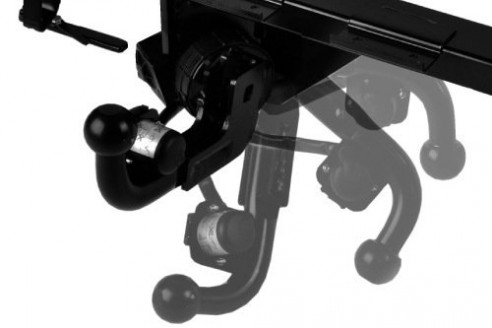
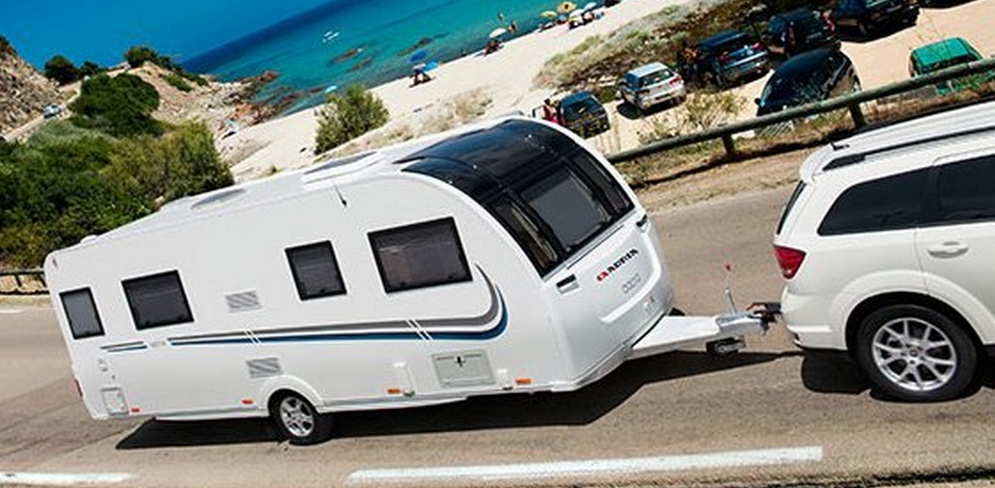
Trailer market
I must say that a trailer in Russia is still far from the most popular product, so the market is rather poorly developed. In the segment of "low-tech" trailers, that is, flatbed and intended for the transportation of equipment, the domestic manufacturer reigns supreme. You will have to choose from trailers MZSA, LAV, KMZ, "Krepysh" and "Trailer".

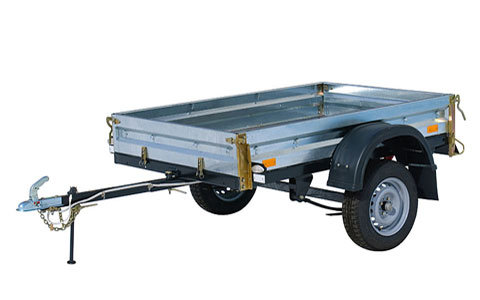
There are also trailers of foreign brands, from imported components, but assembled here. For example, the Estonian-Russian Respo trailers. It is possible to find completely imported trailers, but the choice is small. In particular, take a closer look at the German Falcon or Finnish Finn-Traileri.
![]()
The situation is completely different with caravans. This product is complex, high-tech and expensive. Europeans have vast experience in the production of caravan trailers, and it is European products that dominate this segment. Popular brands include Hobby, Adria Classica, Dethleffs, Sterckeman and Sunlight.

In general, you need to be prepared for the fact that you will not find the desired trailer in stock. The demand is small, so many models are in the price lists, but you will have to order and wait for them for several weeks or even months. Therefore, take care of purchasing a trailer in advance.
How much does a trailer cost?
The price of a flatbed trailer directly depends on its dimensions and equipment. The simplest version of a small trailer "for a summer residence" can be found for 30,000 - 40,000 rubles, and if at a discount, then even cheaper. Slightly more expensive, in the region of 40,000 - 50,000 rubles, are boat trailers of frame construction.
"Bortoviks" for transportation of snowmobiles and ATVs of a larger size will cost 50,000 - 60,000 rubles. Medium flatbed trailers with a rigid plastic roof cost from 65,000 to 90,000 rubles. Heavy two-axle trailers are much more expensive: 120,000 - 150,000 rubles, and the same, but with a kung - already under 300,000.
The most expensive pleasure is mobile homes. A new caravan trailer will cost an amount equivalent to an average foreign car - from 600,000 to 1,500,000 rubles, depending on the size and equipment. There is no upper limit, since by special order the salon can be decorated with at least mahogany inlaid.
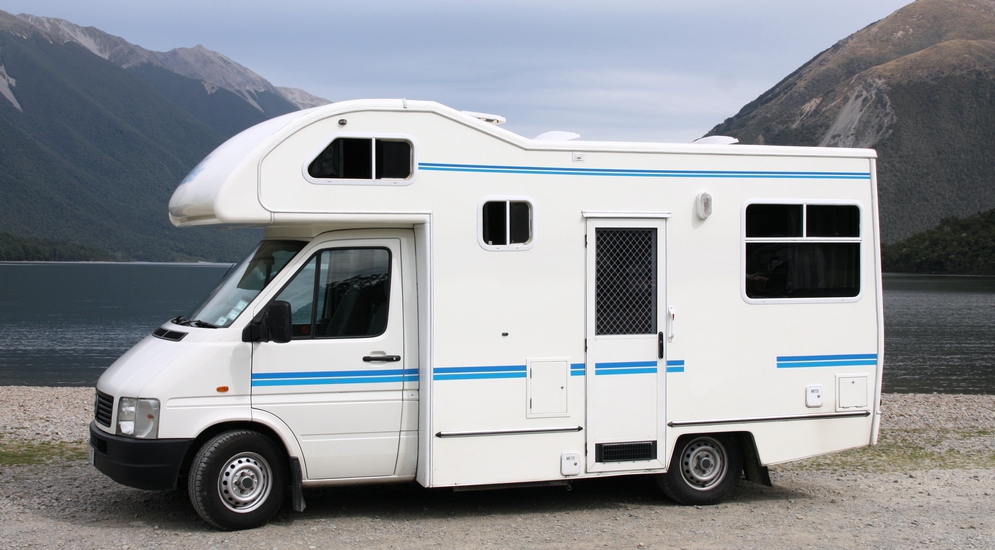
It makes sense to buy mobile homes second-hand: there are not so many equipment that can fail, so with the right approach, you can find a good copy. Prices for trailers that are acceptable in their condition start at 200,000 rubles.
Do you really need a trailer?
But it's true. Before spending your money on buying a trailer, consider whether it is really necessary. If we are talking about a couple of walkers to the dacha with boards, then it is more profitable to hire a truck. Do not forget that you need to not only buy a trailer, but also store it somewhere. And if you are going to leave it for the winter in your summer cottage, remember two things. First, it can be stolen there. Secondly, when in the spring you need to take something in this trailer to the dacha, you will first have to pick it up from there and deliver it to the place of loading. Therefore, before purchasing a trailer, it makes sense to sit down and rationally calculate all the costs and alternative ways of solving the assigned tasks.
Do I need to get a license for a trailer?
It all depends on the mass. When buying a trailer, look at its technical specifications and look for the item "permissible maximum weight", which will mean the weight of the trailer itself plus its carrying capacity. If you want to drive with a category B license, then this weight should not exceed 750 kg.
There are two more conditions. Firstly, the maximum permitted weight of the trailer must not exceed the curb weight of the vehicle. Study the car registration certificate, it is spelled out there. However, even Daewoo Matiz has a curb weight of 828 kg, so only the owners of a 720-kg smart fortwo may have problems in this regard. But who would dream of hitching a trailer to it?

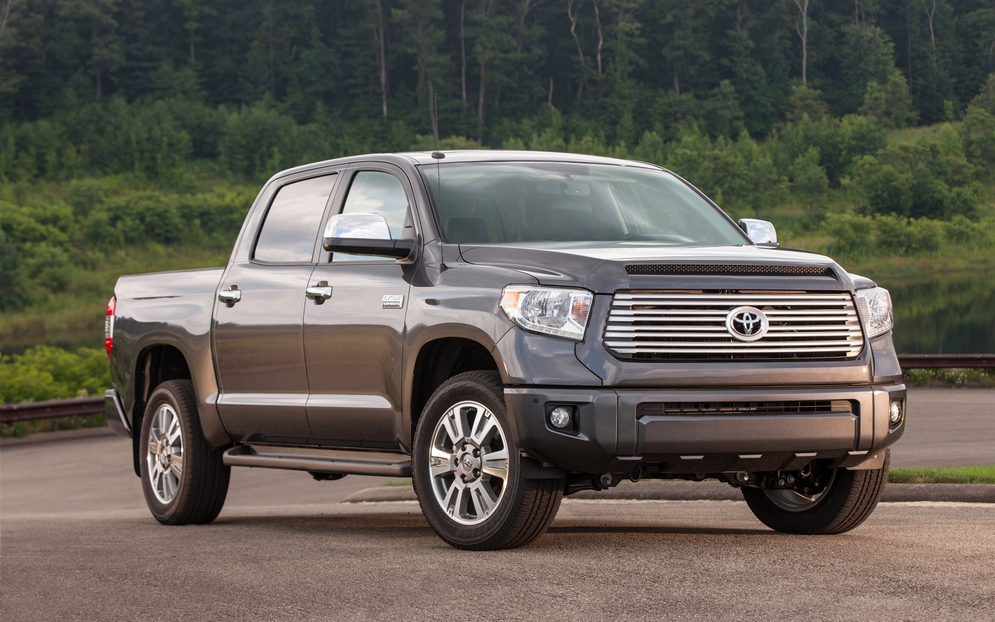
Second, add up the curb weight of the vehicle and the maximum permitted trailer weight. The total should not be more than 3,500 kg. However, this is also far from the most pressing problem, because the weight of even such a giant as Toyota Tundra is 2,612 kg.
In the overwhelming majority of cases, the 750 kg maximum weight limited by law is more than enough. For example, ATVs weighing more than 400 kg are considered super heavy. But if suddenly you decide to transport a small yacht or a caravan trailer, then take a closer look at the prices of driving schools.
How to get a license for a trailer, if necessary?
First, let's define the categories of driver's licenses. There are three "trailed" categories, and each candidate must pass a separate exam. Category BE is suitable for driving a light car with a trailer, CE for a truck with a trailer, and DE for an articulated bus. It is important to remember that any of these "trailed" categories can only be opened after one year of driving experience.
The average cost of a training program at a driving school is 10-12 thousand rubles on a turnkey basis. In the traffic police, by the way, you do not have to take a theoretical exam - it is assumed that you already know the traffic rules. But you have to demonstrate driving skills reverse with a trailer and parking at a simulated unloading ramp.
Will the car pull the trailer?
This is by no means an idle question. Before buying a trailer and hanging a towbar on the car, you need to think about whether it will be difficult for her to carry all this? The best option if the car is diesel. The fact is that heavy fuel engines, all other things being equal, give out significantly more torque, losing in power. And when you need to drag something heavy, then it is the magnitude of the moment that plays the main role.
To understand how the car is capable of pulling a trailer, call four friends, turn on the air conditioner and try to drive up the hill under these conditions. If you feel that the car is barely pulling and is about to stop, then forget about the trailer. Even if your friends are very large men, together they are unlikely to weigh more than 400 kg.
We think ... Even the simplest trailer weighs about 200 kg, plus about 550 kg it can take on board. Accordingly, if a car chokes with an additional 400 kg, then 750 it will definitely be too tough for it. You do not want to stall at one fine moment in the middle of an ascent with a loaded trailer without the opportunity to move on?
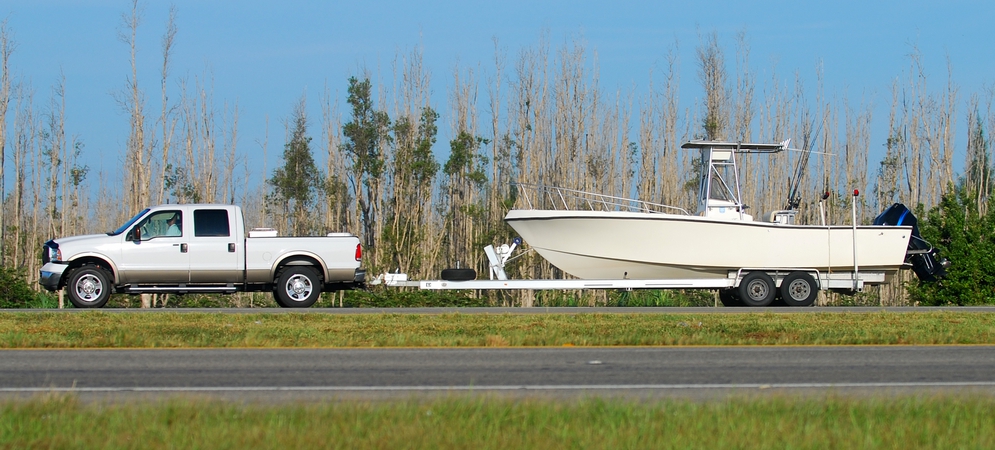
Does any trailer fit any vehicle?
If we are talking about an ordinary light trailer, then, leaving the carrying capacity outside the brackets, any trailer fits any car. The towing hitch for everyone, thank God, is unified. The only thing that may arise is wiring problems, and more on that in the next section.
Installing the tow bar
If all the documents are in order and the weight is calculated, it remains only to install a towbar (or a towing hitch, as engineers call it) on the car. On passenger cars, the towbar has the simplest device: a bracket is attached to the body, and a hook with a ball is located on it. Then the trailer coupling head is put on this ball.
On the towbars of an archaic design, the hook is tightly welded to the bracket. The only advantage of such a system is its low cost, which predetermines its popularity in Russia. But if you have minimal conscientiousness, we recommend buying a hitch, on which the hook can be unscrewed or folded, by removing it under the bumper.
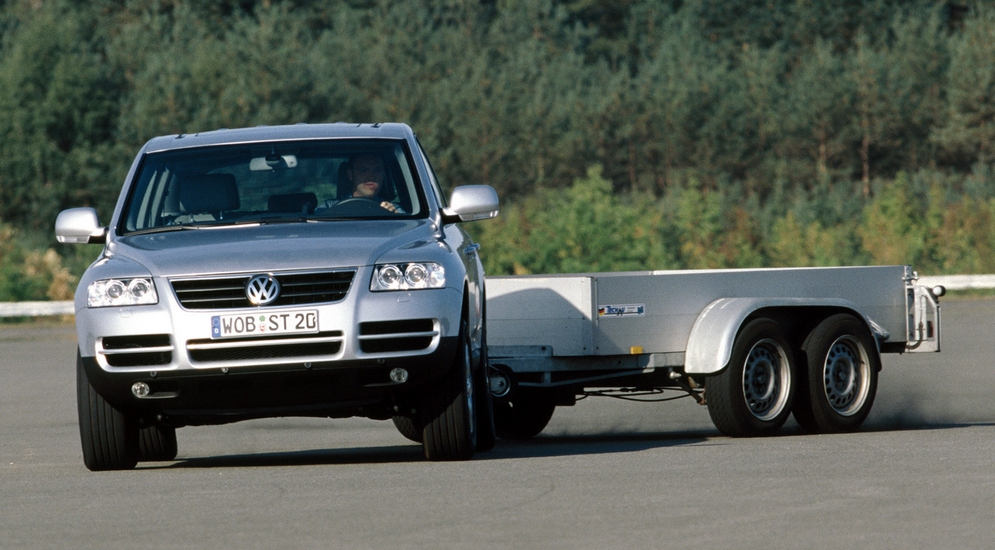
A protruding hook is dangerous in an accident. And if you think that only those who "come" behind you will have problems, then you are greatly mistaken. The towbar bracket is usually attached to the side members, the structural elements of the body. They will, of course, bend when hit hard. And believe me, stretching the side members is going to be a much bigger problem than replacing the bumper, which is designed to absorb and absorb the impact.
In addition to screwing on the towbar itself, you will need to bring the outlet to it to connect the electrical equipment of the trailer. Usually this procedure does not cause many problems, since there is no need to pull the wiring through the entire car: it connects to the rear harness, usually located in the trunk near the rear lights. The cost of installing a towbar, together with electrical work, fluctuates on average in the region of 2,500 - 4,000 rubles.
True, there are a couple of pitfalls. On many modern models It is impossible to simply connect the trailer electrician to the on-board network, you need to install a so-called matching unit, that is, an adapter. It is not cheap - from 4,500 to 9,000 rubles, another 1,500 to 3,000 rubles will have to be paid for the installation. Smart electronics are found not only on luxury cars like the BMW X5 or Volvo XC90, but also on relatively simple cars like the Opel Astra H-J and Volkswagen Golf V-VII.
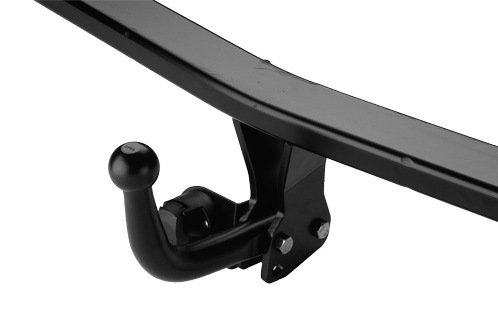
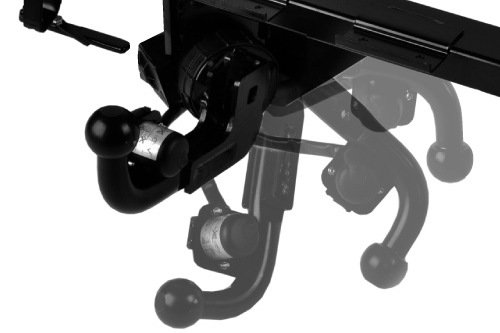
The second point is the type of connector. If you have an American trailer, then a 13-pin connector is required for it, and if it is a European one, then a 7-pin connector. Fortunately, if you need to connect a European trailer to a car with American wiring, it is not necessary to change the equipment, just buy an adapter.
Finally, it can also be noted that the hitch is not a detail that can be saved on. Therefore, choose towing equipment from quality manufacturers such as VFM, Bosal, Westfalia, Brink or Auto-Hak. For now, Chinese products should be treated with caution.
Trailer registration, vehicle inspection, vehicle tax and insurance
Any trailer after purchase must be registered with the MREO. The procedure is completely identical to the registration of any other vehicle. You need to bring with you a sales and purchase agreement, Title Deeds (trailers also have them), receipts for payment of state duties, and in exchange receive special "trailing" numbers and a registration certificate.
The good news is that if you are an individual and your trailer is intended for a passenger car, you do not have to buy MTPL, undergo an inspection and pay transport tax. WITH legal entities everything is more complicated: technical inspection and insurance are needed. But the transport tax is not paid even by the owners of multi-ton trucks. Considering that with their wheels they spoil the asphalt no less than cars, the decision is dubious. But that's the kind of legislation we have.
Additional restrictions when driving with a trailer
The first thing to remember is that for vehicles with a trailer, the speed limits are stricter. In the city we observe all the same 60, but outside settlements- not 90, but 70! On the highways - not 110, but 90. Motorists often forget about this, but the traffic police remember very well. However, driving too fast with a trailer still won't work, because at high speeds it starts to be thrown from side to side.
It is also important that people cannot be transported in trailers, even if you have a mobile home. With regard to cargo, the rules for trailers are the same as for conventional vehicles. The load must not protrude more than two meters from the edge of the body. And if it protrudes from one to two meters, then on its edge (for example, if it is a long board) you need to hang a sign "bulky cargo", although an ordinary rag will do. Well general rule: the cargo should not create noise, dust, stain the road, and also cover the registration plates of the trailer and its lights.
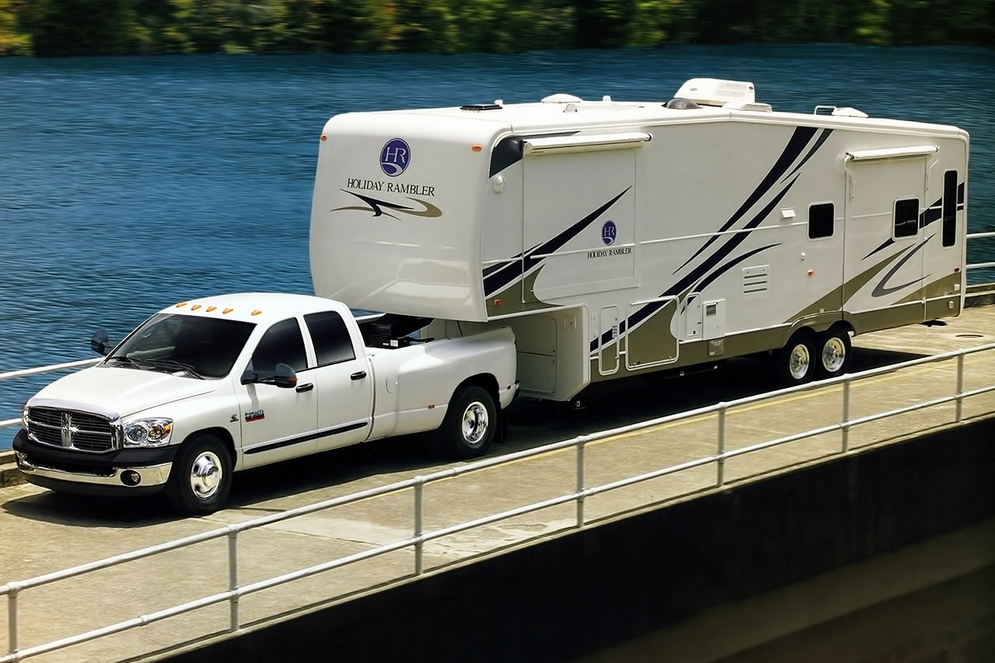
Features of driving a car with a trailer
It is best to start any trailer trip with a brief technical inspection. Ask someone to check if all the lights are on (brake lights, turn signals and dimensions). Rock the trailer, check the shock absorbers. The connection to the towbar is best lubricated with graphite grease. And, of course, check the tire pressure. Another tip: keep under control the tightening of all bolts. The Russian assembly is a delicate matter.
You need to drive carefully with a trailer. Remember that you will need a lot more space to overtake and you will gain speed more slowly. Take special care of trucks. A light trailer will chatter with the currents of air that heavy vehicles create. Therefore, if possible, it is worth staying away from them altogether.
Careful on tracked roads! If you are accustomed to driving between crushed grooves, it is better to drive with a trailer along the trajectory beaten by other cars, because the trailer tends to "slide" into a rut. Remember also about the increased turning radius, which with the trailer must be traversed in a large arc, otherwise you run the risk of "throwing" the trailer on the sidewalk.
The most difficult thing is driving with a trailer in reverse. When you turn the steering wheel to the right, it will go to the left, and vice versa. You need to get used to this and it is advisable to practice on an empty parking lot at night.
Modern freight transportation ensure the delivery of various materials over long distances. For this type of transport business, it is important to reduce the number of flights, which helps companies to maximize profits.
To achieve these goals, semi-trailers are usually used that optimally meet the requirements of the transport companies. A semi-trailer is a vehicle whose front end rests on the fifth wheel of the tractor.
The rear of the trailer is equipped with its own wheel axles. This design has a positive effect on load distribution and vehicle handling. The types of semi-trailers differ in the number of their own axles, type of suspension and load capacity.
In addition, the models are subdivided according to the category of the transported cargo. Modern market special equipment, offers customers about 500 types of semitrailers. In this article, we will look at the main variations designed for the transportation of liquid, bulk and indivisible cargo.
Tilt semi-trailers
The most popular among the presented models is the tilt semitrailer. Such designs are optimally suited for furniture transportation, various equipment, building materials, food and industrial goods.
The key characteristics of this category are the following elements:
- Awnings are made of durable material that is not susceptible to external environmental influences. Accordingly, the transported goods will be reliably protected from moisture and dust.
- Various design variations. In particular, the roof of a semitrailer can be hard or soft, moving parts are often found.
- Ease of use. Here you can note such nuances as removable frames, sliding roofs or side panels.
This category is divided into two groups: flatbed and curtain semitrailer. The first option is usually used for the transportation of building materials that do not require special storage conditions. 
Such models can be equipped with folding sides, special rings through which the torso passes to fix the load.
The second option is used for the transportation of bulky goods. Here the upper part or side flaps can be moved, which greatly simplifies the process of loading / unloading the semitrailer.
Tank trucks
The tank is designed for the transportation of liquid cargo, respectively, suitable for oil and products of its subsequent processing, food products, such as milk.
In the latter case, tank semitrailers are regularly sanitized and have the appropriate certificates.
Please note that the inner surface of such a container is covered with special materials, or treated with a substance that is neutral to the transported liquids.
In fact, tanks are sealed containers that are equipped with devices for filling and emptying. For this, a system of filling / unloading valves and sluices is used. 
Usually, the design includes counters that control the amount of fluid being drained. Please note that tanks can be used to transport bulk goods such as flour, grain (grain carrier) or mineral powder.
A separate category is a cement semi-trailer. These models resemble a V-shaped design, with top loading and emptying through a bottom sluice. Typically, these models are made from wear-resistant materials such as high-strength steel.
For cement carriers, a three-axle chassis is characteristic, the volume of a barrel is from 20 to 45 m3. Note that the filling / emptying rate varies between 500-700 kilograms per minute. 
In some modifications, loading / unloading is not carried out by gravity, but by means of compressed air, which reduces the downtime of machines at construction sites. Such models are equipped with two compressor stations.
Refrigerated trucks
Such models differ increased level tightness and are used for the transport of perishable goods. Vehicles are divided into two groups:
- Refrigerator. This is a semitrailer made of insulated material and equipped with its own refrigeration unit. As an insulating base, a foam material that is resistant to moisture and destructive processes is used here. The side walls and roof of the semitrailer are made of sandwich panels, with an outer sheath of durable plastic or metal. Such a scheme reliably isolates the transported cargo from contact with the external environment, ensuring its safety. The built-in refrigeration unit maintains an internal temperature of -25 / + 25 degrees, depending on the load.
- Isothermal semi-trailer. The structure is intended for the transportation of perishable goods within the city. In fact, it is a large thermos that protects the load from contact with environment, but not intended for long-term storage of products.

Container ships
As the name implies, the container ship is designed to transport freight containers. Considering that the transported cargo usually has standard dimensions, almost all models of container semitrailers are equipped with a unified rigging system.
- Standard. The frame length of such a semitrailer is 12.5 meters, which makes it possible to place two 20-foot containers on the site, or one 40-foot container.
- Low frame. The semitrailer is designed for the transportation of dry cargo containers with an increased volume of internal and external space.
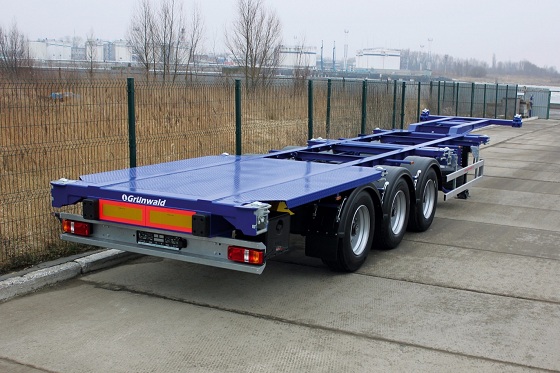 Note that almost all models are equipped with retractable rear and front platforms, which simplifies the loading process.
Note that almost all models are equipped with retractable rear and front platforms, which simplifies the loading process.
Trawls
The second name for such semi-trailers is low loader heavy trucks. The main purpose of these structures is the transportation of oversized or heavy cargo at any distance.
In particular, low loader trucks are used to deliver heavy construction equipment to the work site. Immediately, we note that this is a rather profitable way: special equipment can be transported in full configuration, accordingly, it can be used literally "off the wheels" at the construction site.
For ease of transportation, low-loader semitrailers are normally equipped with special ladders that help the technician to enter the site. Note that the number of axles in heavy trucks is usually greater than that of flatbed semitrailers.
In addition, low-loader heavy trucks are equipped with pivot axles in order to reduce dynamic loads and increase wear resistance. 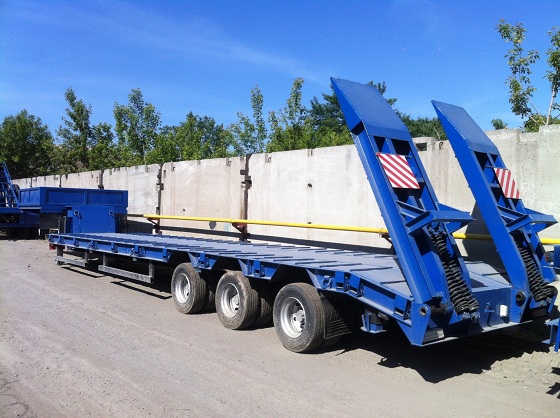
Car transporters are an interesting variation of trawls. The models are designed for long-distance transportation of freight and light vehicles. The capacity of the double-deck platform helps to transport up to 12 cars.
Some modifications are equipped with additional boards or awnings to protect products from small stones.
Tractor
In agriculture, a tractor semitrailer is widely used. The lineup consists of the following variations:
- Dump. The most popular category that provides fast unloading of bulk materials. Please note that unloading can be done on one or three sides.
- Onboard. Designed for the transportation of indivisible goods.
- Bulk. Almost complete analogue of the previous category, adapted for the delivery of bulk materials.>

Timber trucks
The timber semi-trailer is used to deliver logs or sawn timber. Such structures are characterized by the use of U-shaped frames, which reliably fix the logs on the site.
Such clamps are called bunks, they are stationary or mobile. The second option is more versatile and allows you to adapt the semitrailer for transportation of tree trunks of any length. 
Timber trucks are divided into two types:
- All-metal - timber trucks.
- Sliding - dissolutions.
The peculiarity of the timber trucks is the increased cross-country ability and a reliable frame.
In logging, wood chip semitrailers are often used. The technique resembles a curtainsider semitrailer adapted for transporting chopped wood.
Semi-trailers can be used not only for their intended purpose, but also to deliver goods such as peat, straw or expanded clay. A distinctive feature of chippers is the movable floor structure.
TELL YOUR FRIENDS
In contact with
› Car trailer. How to choose and what to look for.Today it is impossible to imagine a vehicle without such a simple and practical device as a trailer. The trailer can carry a wide variety of goods, and even other vehicles and equipment: ATVs, snowmobiles, boats, boats, motorcycles.
If we talk about the history of the creation of the trailer, then, oddly enough, it is attributed to a woman. So Berta Benz, the wife of Karl Benz (the creator of the first car), back in the 19th century, when testing one of the motorized carts, tied a trailer with belongings to it, this was the world's first trailer. Of course, it was too early to talk about any standards then, everything was just being systematized and what was being said was getting on its feet, but today we already have certain ideas about how a full-fledged trailer should look like, which suspension would be preferable for us, which coupling device is better what weight to be transported we reckon on based on the engine power and the characteristics of the body of our car
Types of trailers
First of all, I would like to say about the carrying capacity of trailers, so trailers with a curb weight (trailer weight + load weight) up to 750 kg are considered light trailers and more than 750 kg heavy, while heavy ones must be equipped with their own autonomous braking system.
In addition, trailers for cars are universal trucks, the most common, designed to transport a wide variety of goods and trailers for special purposes. If everything is clear with universal trailers, then the special-purpose category includes:
- dump trailers for transportation and fast unloading of bulk cargo;
- tanks for transporting liquids;
- trailers for transportation of motor vehicles - boats, hydro-motorcycles, snowmobiles, go-karts, etc .;
- auto transporter trailers are designed to transport cars;
- tourist trailers for transporting luggage, as well as, together with the function and ensuring a comfortable stay for travelers;
- trailers-houses - the name speaks for itself, a mobile home with a wide variety of human amenities, it all depends on its value and your desires;
- commercial trailers - mobile pavilions for trade on the street, for example, trade in cotton candy, ice cream, grilled chicken, as a rule, in our country is carried out from such trailers. Must be equipped with the necessary equipment (stove, refrigerator, display case, etc.);
- trailers for transporting animals (for example, they are actively used to transport horses of the mounted police in Moscow).
Now let's look at the structural elements of trailers.
Structural elements of trailers for cars
The trailer is much simpler in comparison with the design of the car; the following body and structural elements can be distinguished in it: frame, drawbar, body and suspension.
The frame of universal cargo trailers is usually made of a channel, welded in the form of a rectangle with reinforcing straps. In specialized trailers, the frame, as a rule, is complex and depends on the cargo being transported, for example, for a boat, the frame has the shape of a parabola for basing the boat on the trailer.
Drawbar - an element that plays the role of a link between the trailer and the car. During transport of the trailer, compressive and tensile loads are transferred to it. Also, at the base of the drawbar attachment, sometimes significant torque is generated, especially when the trailer is loaded unevenly or on an uneven road during swinging. The drawbar is usually made in the form of an A-shaped or I-shaped form. Also on the drawbar there is a hitch assembly, safety chains or cables, a retractable stand (if provided by the manufacturer).
It is worth dwelling in more detail on the trailer hitch assembly. If, as we said earlier, the trailer has a maximum permissible weight of more than 750 kg, then the trailer's brake system elements, as well as damping elements are mounted in the hitch unit (see the figure below)
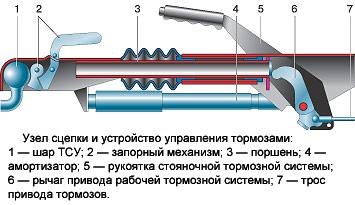
It can be seen from the figure that the coupling device, firstly, has a pivot hinge formed from two mating parts, the ball of the tow bar - 1 and a cup of the corresponding diameter of the coupling. A locking mechanism with a safety lock is provided to prevent the cup from flying off the ball - 2.
Some of these assemblies are a ball-sphere that has an adjustment of the gap between the mating parts, in order to be able to "select" the changed size due to wear of the parts. The diameter of the ball should be 50 mm with a tolerance of minus 1 mm, that is, when the ball is 49 mm, it must be replaced. The minimum distance between the center of the ball and the bumper on the car must be at least 6.5 cm, this is the size that guarantees a safe hitching of the drawbar for body elements in the event of a turn. Before placing the cup on the ball, use a grease lubricant to liberally lubricate the ball.
The drawbar can also accommodate a spare wheel for a trailer. The drawbar can be foldable or removable. Also, in the case of transportation of long lengths, it can be extended by installing an additional link.
The safety ropes (chains) speak for themselves, they secure the trailer in case the drawbar cup falls off the towball ball. Operation of the trailer without such ropes (chains) is not allowed.
The foldable stand serves for the convenience of installing the trailer in a horizontal state without the need for a car fork, and also simplifies the operation of connecting to it.
The body of the trailer depends on its direct purpose, so for cargo trailers it is just sides, for a trailer it is a house on wheels, this is a house, for trailers for transporting equipment instead of a body, adjustable planes are used for the wheels of equipment, etc.
The capabilities and functionality of each individual body will depend on your financial capabilities. So the sides can be built-on and removable, with an awning roof, the body of the house can be made insulated, with a reinforced frame and structural elements for built-in household appliances. A trailer for vehicles, can have a fiberglass roof, adjusting winches, for reliable release of the transported cargo.
Trailer suspension
Passenger car trailers can have one or two axles. A trailer with two axles and a distance of less than 1 meter between them is called a twin-axle trailer. The rest are, respectively, in terms of the number of axles, biaxial and uniaxial. Let's take a closer look at each of the types of trailer suspensions found.
Dependent suspension trailers.
The dependent suspension has its own advantages and disadvantages. The advantages include a more "assembled" design, which allows you to overcome off-road with the possibility of hanging one of the axles, while this property will save the trailer from landing on the bottom.
At the same time, on the track, such trailers are prone to overturning when cornering, this again refers to the properties of the suspension structure.
Dependent leaf springs consist of a beam and leaf springs installed on it. Also, for smoothness, there are two shock absorbers on each side, one at a time. The suspension is the same as the suspension trucks, this is its plus: a significant weight of the transported cargo, reliability and simplicity. The disadvantages include poor smoothness when overcoming irregularities.

- Spring dependent completely repeats the above described option, with the exception of the use of springs instead of springs. This suspension is softer, but also less durable. Springs working under load tend to sag after 4-5 years. The trailer loses the smoothness of overcoming irregularities, the possible carrying capacity decreases.
A special feature is the longitudinal thrust. The springs are not as stiff as the springs, and without traction, the bridge simply will not hold in its position, it will be taken to one side or the other, while the springs can jump out of their mounting cups.
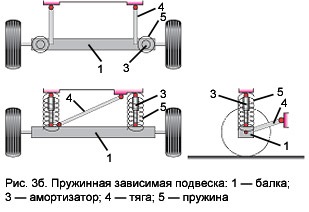
Independent trailer suspension.
This suspension responds more dynamically to road changes, is able to “absorb” its irregularities, and is more stable when cornering.
- Lever-spring independent has levers located in the direction of travel or perpendicular (not fundamentally), shock absorbers and springs are fixed on the levers. The suspension is "soft", stable in cornering.
The rubber-braided independent suspension consists of a longitudinally fixed tube with shock-absorbing profile elements (rubber) inserted into it and a rod in the center for each of the wheels. At the end of the rods there is a lever to which the wheels are attached. The suspension is not serviced; if it is worn out, it will not be possible to restore it. When replacing, the entire bridge will have to be replaced.
By itself, soft and smooth, has a significant limitation in carrying capacity.
Often installed on trailers with a double axle, for transporting boats, boats

- Independent torsion bar suspension has long been proven in passenger cars. The torsion bar is attached to the body, and there is a shock absorber at the end of its arm to dampen vibrations.
In terms of operational properties, it is similar to a rubber-harness suspension. If the torsion bar breaks down, as a rule, it simply breaks down from the torsional effort, you have to change an expensive element - the torsion bar.
Trailer chassis
As a rule, the manufacturer tries to adapt to the wheel standards of the existing wheels. The most popular trailer disc sizes are 13 or 14 inches. Hence the dimension of bearings, hubs, etc. For most domestic trailers, disks from the Zhiguli and Lada models are suitable. Also used are disks from the "Moskvich" and "Volga" cars. Some trailers have a flange drill that allows you to install different standard sizes of discs, respectively wheels.
Requirements for tires installed on a trailer are similar to those for tires installed on a car:
- the height of the tread pattern is not less than 1.6 mm;
- it is not allowed to install diagonal tires on one axle of the trailer together with radial ones, as well as with different tread patterns.
Braking systems of trailers
An increase in mass inevitably entails an increase in inertia. In this case, it does not matter whether the vehicle-trailer link is stationary or in motion. A significant increase in inertia entails an increased load on the vehicle's braking system, which affects its resource and efficiency. Traffic rules prescribe the braking distance for a car with a trailer on a flat dry surface at a speed of 40 km / h not more than 13.6 m3.
Also, holding a trailer (especially with a load) on an incline with only one hand is also problematic. So how are these tasks solved?
Service brake system - it is this system that is installed on trailers with a permitted towed weight of more than 750 kg. The system is autonomous and works while towing a trailer.
The principle of operation is as follows. When the car starts to roll more slowly relative to the trailer, that is, it slows down, the trailer rests against the hitch, while force is transmitted through the piston (see Figure 2) to the cam of the lever - 6, connected by a cable - 7. The cable is pulled out, the brake pads in the drums are pulled apart, the trailer brakes ...
The disadvantage of this system is braking the trailer when reversing. This problem is solved as follows, the piston is blocked, the system loses its activity. There are also other types of braking service braking system.
Parking brake system - used for braking the trailer while parking. Usually parking system tied to the working one and also spreads the brake pads in the drums, only by means of the lever handle (see Figure 2)
Emergency brake system - designed for an emergency case, the coupling is broken, an additional safety cable is pulled, its movement is slowed down by the trailer
Wiring and lighting on trailers
Today, all trailers leaving on public roads must be equipped with the following lighting devices without fail:
- orange direction indicators;
- red brake lights on each side;
- parking lights in red on each side;
- license plate illumination;
and reflectors:
- two back triangular red (the vertices of the triangles should be directed upwards
- two front round reflectors white;
- two side reflectors of orange color.
Also trailers can be additionally equipped with:
- Fog lights (if not provided by the manufacturer, then operation without them is allowed)
In addition to the above requirements, if the trailer is wider than 1.6 m, the front dimensions are also installed in white. If the trailer is longer than 6 m, two orange side marker lamps are installed.
All lighting devices are powered from the on-board network of the car through a standard socket installed on the towbar. For more information about connecting the trailer power supply to the vehicle's on-board network, see the article "Connecting a trailer hitch on a car"
Before purchasing a trailer for a car, you should pay attention to the following factors:
- The maximum permissible mass of the towed trailer, should not be more than permissible for towing by your car;
- The same standard size of disks and standard size of tires of the trailer and the car will allow you to use your spare wheel for the trailer and not carry two spare wheels with you;
- Pay attention to the suspension. A softer, but not so load-bearing spring (torsion bar) suspension will allow you to transport your loads more carefully, especially off-road;
- Pay attention to supporting systems (availability braking systems, drawbar stands, side clamps, weather awning) all this will subsequently save you time and nerves;
- In the end, take an interest in the maintainability of the trailer, the availability of spare parts for it on the market, so that one day you will not become the owner of a real estate or a semi-factory with handicraft components
How to load the trailer correctly
The center of mass of the load must be on the trailer axle, in this case the load on the coupling device will be minimal. In addition, you will eliminate the influence of the load on the rear suspension and the car body, relieving them of unnecessary load - lifting or downforce. This will extend the operating period of the trailer and tow bar, and will not affect the car's handling due to changes in the load on the rear axle. In this case, the load must be well secured, in order to exclude the possibility of its displacement or even more loss.
The maximum permissible constant load on the ball is from 30 to 90 kg, the greater deviation can only be short-term (the phenomenon of impact on uneven roads). In any case, while driving a trailer, keep a speed of no more than 70 km / h on the highway, think about increased inertia, and about changing dimensions. You can learn more about driving a trailer from the article "Driving a car with a trailer"
3 years
The need to buy a trailer arises when a car enthusiast is faced with the task of transporting bulky cargo, and the vehicle's capabilities are not enough. In addition to the difficult choice among the variety of models, drivers have questions about the need for insurance, registration of this type of transport. And, in general, what category of rights allows driving a car with a trailer?
Will it be necessary to open an additional category for the trailer?
If the car owner has a driver's license with an open category "B", he is allowed to drive a car (weighing no more than 3.5 tons) with a trailer, provided that the mass of the latter does not exceed 750 kg. In this case, you do not need to open an additional category to drive a vehicle with a trailer.
It is also allowed to drive a vehicle coupled to a trailer weighing more than 750 kg if the total weight (vehicle + trailer) is not more than 3.5 tons, and the trailer does not exceed the vehicle's unloaded weight.
If the mass of the trailer is greater than the indicated figure and, together with the vehicle, the mass is higher than 3.5 tons, the driver will need to open the BE category.
Do I need to insure, carry out technical inspection and register a car trailer?

After buying a trailer, you must register it with the traffic police within ten days. To complete the registration, you will need to collect a package of documents:
- purchase and sale documents;
- trailer passport;
- owner's passport.
With these documents, you need to come to a registration department that is convenient for you, pay the state duty, provide the trailer for inspection and pick up the executed papers.
If the buyer of the trailer is an organization or an individual entrepreneur, then you need to conduct a technical inspection of the vehicle and issue an insurance policy. But if the trailer is new (including the year of manufacture). If the trailer is not older than 7 years, then the regularity of the technical inspection is 2 times a year, more than seven - every 12 months. It should also be remembered that the first maintenance is carried out before the registration of OSAGO.
Types of trailers for a car
A caravan is a vehicle without an engine, designed to move in conjunction with a truck, car, motorcycle and other vehicles.
Trailers can be divided into two categories:
- specialized;
- freight.
We will consider each type in more detail below.

Specialized trailers for passenger cars
Such structures are intended for the transportation of special cargo. They cannot be found in a large assortment in stores, since, as a rule, they are made to individual sizes.
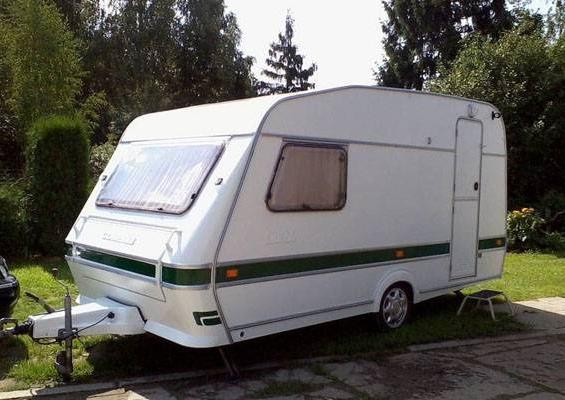
These include caravan trailers - this is a type of light trailers designed for lovers of travel and outdoor recreation. Also in the category of specialized vehicles are trailers for transporting livestock, boats, yachts, snowmobiles, boats, secondary vehicles, etc.

Cargo trailers for passenger cars
This category includes trailers designed for the transport of goods, as a rule, such equipment is equipped with awnings and folding sides. General purpose trailers are ideal for transporting bulky cargo - boards, bags, spare parts, etc.
Parameters of trailers for cars
Trailers are biaxial and uniaxial.
- Biaxial
This type of trailer is equipped with 4 wheels and has great stability. Since maneuverability is reduced by the number of wheels, these trailers are equipped with slewing devices, which helps to solve this problem. However, reversing is more convenient with two-axle trailers. This type should be chosen if you plan to transport a heavy load.
- Uniaxial
Trailers with one axle have two wheels. These trailers easily change direction as the wheels move freely. They are much more maneuverable than biaxial ones, but they are inferior to them in stability.
When choosing a caravan, you need to decide on the suspension.
- The leaf suspension is much more profitable from a financial point of view, as it costs less. However, this type of suspension does not cope well with country roads and wears out quickly. This option is suitable for even expensive.
- An independent suspension is more expensive than the first option, but with proper operation it will last longer. If you are purchasing a trailer for driving on bumpy roads, this is the best option.
Trailers intended for the carriage of goods weighing more than 750 kg must be equipped with brakes. Lighter trailers do not always have a braking system.
When buying a trailer made of iron, you should understand that corrosive processes are inevitable, therefore, after purchasing, you should treat the metal surface with an anti-rust agent.

How to load the trailer correctly?
To increase traffic safety, it is necessary to properly load the trailer.
The load should be distributed evenly over the entire area of the trailer. In the case of large-sized products, it is necessary to distribute them above the axis (uniaxial) or between the axles (biaxial).
How not to ship:
- shifting the load to the rear of the vehicle will often lead to loss of traction of the rear wheels with the road;
- shifting the load to the front of the trailer will cause the front wheels to lose traction.
Both options can lead to emergency, therefore, when loading the trailer, you need to remember that the load should be distributed evenly.
Features of driving a car with a trailer
You need to drive carefully with a trailer and remember a few basic points:
- the permitted speed with a trailer outside settlements is 70 km / h, on highways - 90;
- it is not allowed to carry people in the trailer;
- the cargo should not protrude more than two meters beyond the sides and cover the registration plates;
- all lights (turn signals, dimensions) on the trailer must be in good working order;
- more space will be required to overtake with a trailer;
- when driving backward and turning the steering wheel to the right, the trailer travels to the left and vice versa.
You should be careful when driving past trucks, because the air flow can cause empty trailers to dangle along the road and when driving on a track, because the trailer always strives to slide into it.
How to attach a trailer?
To hitch a trailer with a car, it is necessary to install a towbar on the latter. A bracket with a hook and a ball is attached to the vehicle body. There are models in which the hooks are welded tightly, they are cheap. Experienced motorists recommend purchasing towbars with unscrewed or folding hooks. This option, although for the money and not more profitable, but safer.
The towbar bracket is usually attached to the side members and in the event of an accident, it naturally bends them. And pulling out the structural elements of the body is a more serious problem than replacing the bumper.
In addition to the towbar, you must purchase a socket for connecting the electrical equipment of the trailer. You do not need to pull the wiring through the entire car, usually the wires are connected to the rear harness located in the trunk near the lights.
How much does a trailer cost?
Simplest flatbed trailer for household needs will cost an average of 35,000–45,000 rubles.
You will have to pay a little more for specialized trailers for transporting snowmobiles, ATVs, boats - from 50,000 rubles.
Heavy two-axle trailers cost from 100,000 rubles. But mobile homes are much more expensive - from 650,000 rubles.
When choosing a trailer for a car, you must first decide on the purposes for which it is purchased. If the main task is to transport not heavy loads on a flat road, a single-axle trailer will do. If you plan to transport bulky items, it is better to choose a technique with two axles.
You also need to keep in mind that driving with a trailer has its own characteristics, namely, limiting the speed limit, reducing maneuverability and other points. Subject to the rules of the road, carrying out the correct loading and careful choice of the model, the trailer will not cause trouble.
Every car owner is faced with the need to transport bulky items that simply cannot fit in a small trunk. There can be two ways out of this situation: either hire a driver with a driver, who will be paid for the amount of time worked, or purchase a larger car.
If both methods turn out to be unacceptable, you should think about buying a small trailer, which in any situation will help you quickly and reliably transport things, vegetables or even building materials.
A trailer for a car must be selected depending on the specific needs, it is the owner's needs that determine its necessary technical characteristics.
Choosing a trailer
Most people buy caravans due to the need for seasonal transportation of fruits and vegetables, others like to travel, and for long distances in your own car, you need to take a lot of things with you. Often the amount of cargo is so large that it requires a special trailer that can accommodate not only clothes and food, but also a boat with a tent.
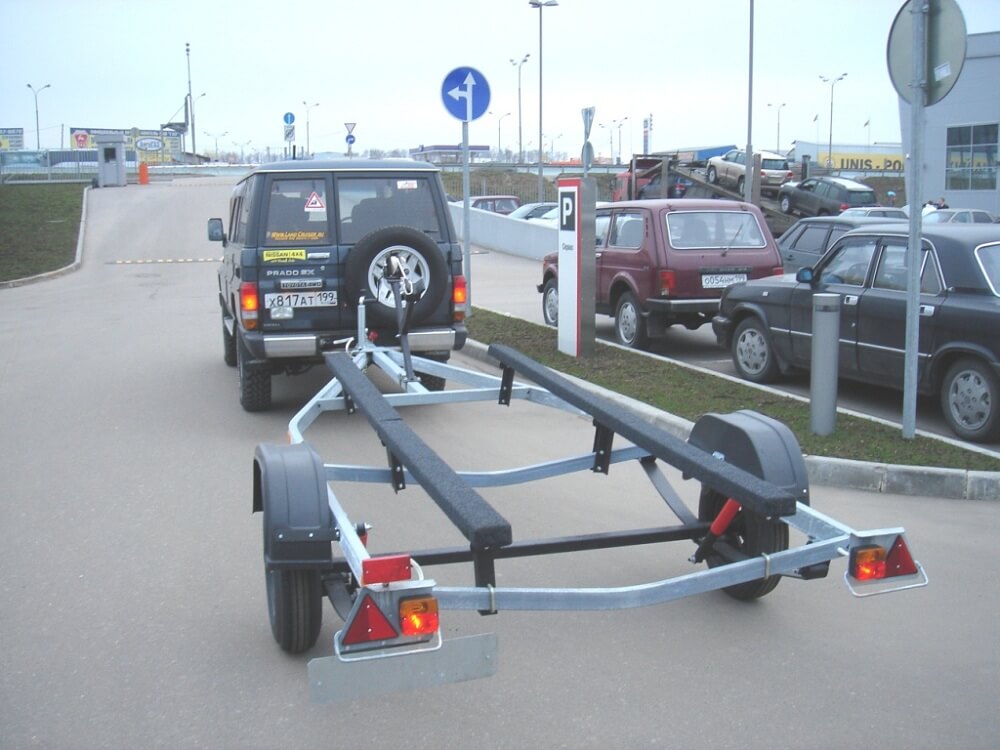
Therefore, you should not overestimate the capabilities of the machine: some types of cargo, if incorrectly transported, can cause harm outward appearance interior or trunk. Before purchasing, you should think about the power of your own car, some cars will not be able to "pull" a large, fully loaded trailer. Let's deal with its types and purpose.
What should you pay attention to?
For your own needs a trailer, do not think that you can make a good purchase right away. The choice of the right "helper" depends on his technical characteristics, maximum permissible weight and type of attachment to the vehicle. So, according to the weight category, trailers are divided into the following groups:
- lightweight (its weight does not exceed 300 kg);
- medium (weight ranges from 300–600 kg);
- heavy (weighing over 600 kg).

It is important to remember that a hitch bought once will regularly affect the wear and tear of the car, since any additional load increases the impact on all power units.
Differences in the number of axles
A car trailer can be distinguished by the number of axles. Accordingly, both uniaxial and biaxial units are available on the market. What can the number of bearing axes give to the structure?
Is one axle better?
Trailed devices, in which only one axle is provided, allow their owner to easily and confidently perform various types of maneuvers. In addition, the mass of such a structure is much less than the weight of a two-axle trailer. The main advantage of this type of structure is ease of handling: if it becomes necessary to turn a single-axle trailer, then even one person can easily cope with this task, while with a two-axle structure this cannot be done.
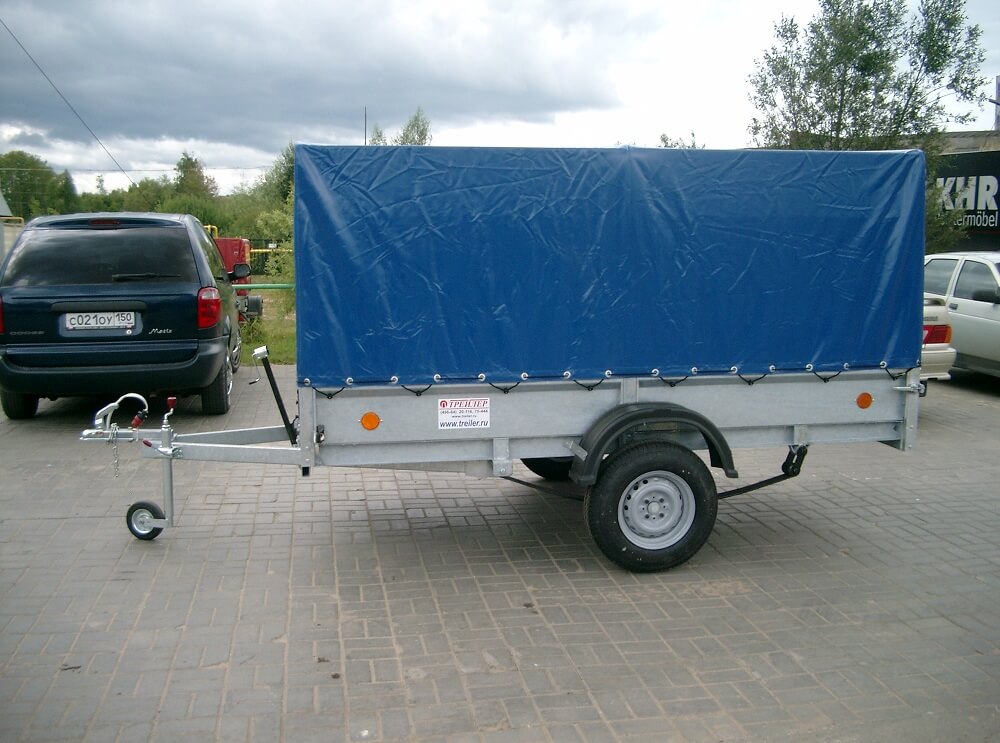
However, a single-axle trailer will only allow you to transport a load that has a relatively small mass. The items or devices being transported should be placed very carefully in order to place the weight as evenly as possible. The load on the coupling unit must never exceed 70 kg. Choosing a single-axle or two-axle trailer, initially you need to think about everything and "weigh" well, so as not to make a mistake and then not to regret the money spent in vain.
Two axles are more reliable
Naturally, a two-axle trailer is a guarantee of stability and high carrying capacity. It is more reliable and powerful and will allow you to transport heavy loads over long distances. However, despite the apparent advantages, the two-axle trailer has its drawbacks. The large weight and dimensions complicate the task of manual turning. Most likely, it will not come out even to roll it up a little, if necessary. A two-axle trailer is better than a single-axle trailer when it is necessary to transport a load with a very large mass.

If a biaxial model is preferred, an overlapping structure can be purchased. Light trailers of this type are capable of withstanding a load of 350-700 kg on each of the four wheels, the maximum permissible weight depends only on the type of wheels installed. A two-axle trailer is also better if you need to transport very large loads with a high center of gravity - four wheels will provide good stability.
Varieties of the brake system
Until now, you can meet people who consider the presence of a brake on the towing device as some kind of innovative solution. The braking distance of a car with a trailer without brakes will be several times longer. There are times when the trailer independently while driving can "move away" from the machine. Therefore, opting for a biaxial design, you should buy an equipped unit. It should be borne in mind that the use of a trailer with a load over 750 kg without brakes is prohibited by traffic rules.
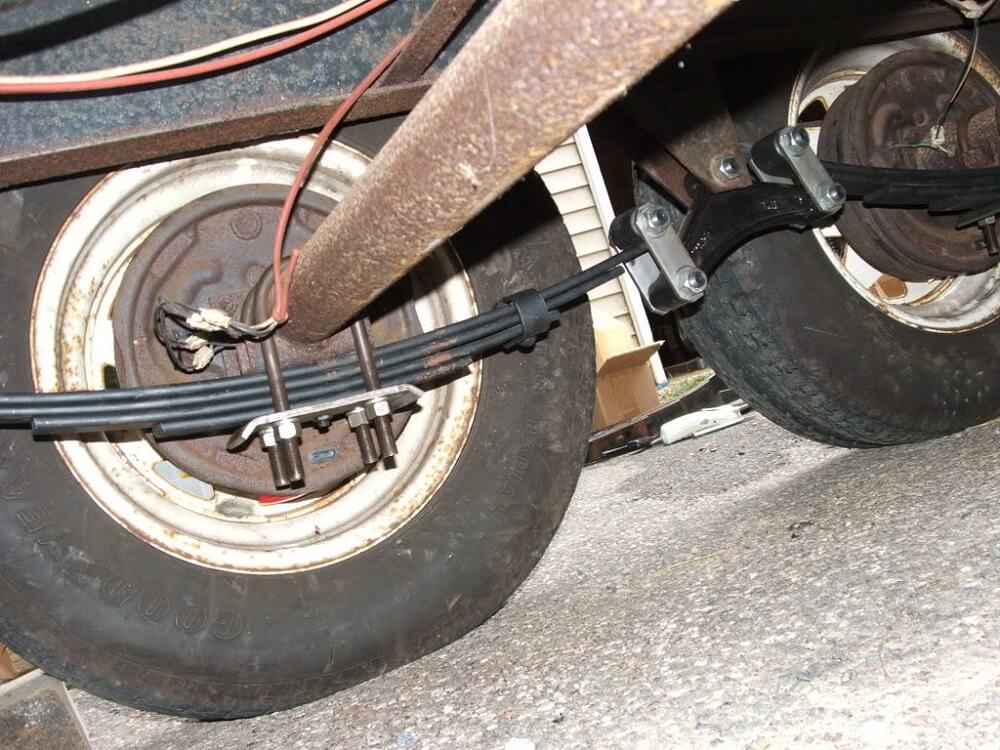
The brake device is very simple: if the person driving the car starts to slow down, the pendulum system automatically moves the pads closer to the drums. Active braking from the machine side provokes the same active deceleration of the trailer. Trailed brakes are also equipped with two additional devices - parking and emergency. The principle of operation of the first is similar to a car "handbrake", the second brake is a cable, which is fixed with one side to the body or frame of the car. If the machine is disconnected from the trailer, the cable stretches, while pinching the shoes and stopping the unit.
Types of suspension of the hitch
The suspension of trailers, which are used for the transport of goods by means of cars, can be of two types:
- spring;
- rubber-cord.
Springs
The best are rightfully considered those trailers on which foreign springs are installed, domestic ones, due to their poor-quality assembly, are not particularly popular. In imported counterparts, in the absence of cargo in the trailer, one sheet functions, all the others begin to work only when loading occurs.
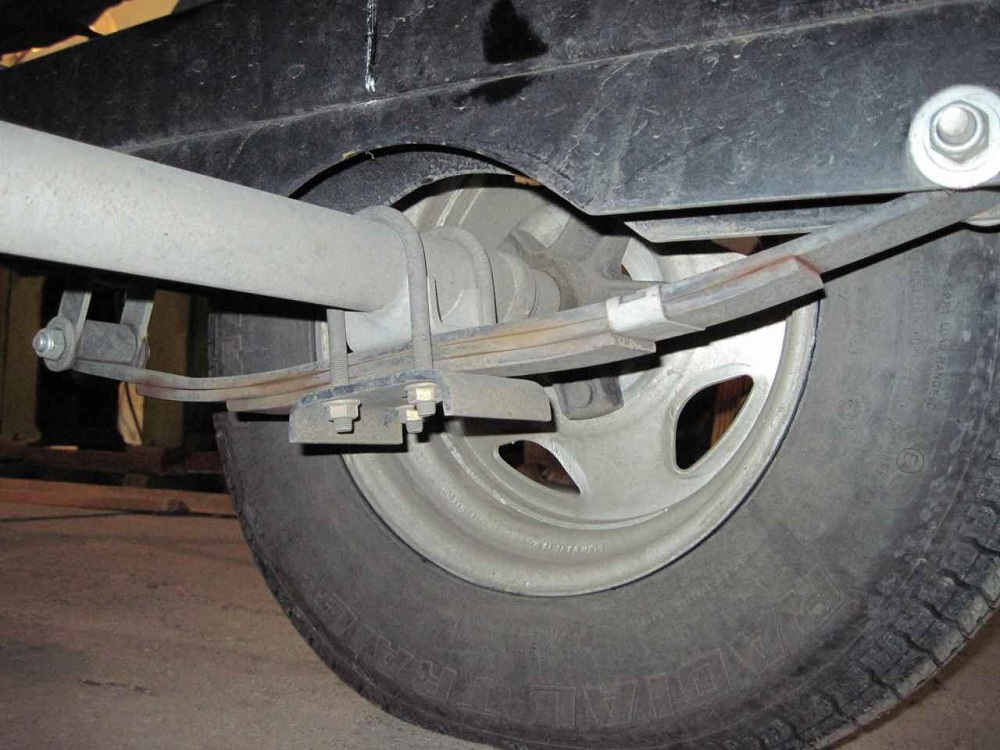
Despite the fact that with springs it well absorbs the vertical vibrations that occur during movement, which is facilitated by friction between the sheets, after buying such a trailer, you still have to install shock absorbers, and this entails a high final cost of the structure and quite expensive maintenance.
"Harness"
In turn, the rubber-braided suspension costs several times cheaper, and it hardly needs maintenance. The only weak point of this type of design is the wheel bearings, they should be replaced in a timely manner. The suspension is capable of withstanding loads over 500 kg. The rubber-braided suspension device is a pipe with a specific section and two bent levers.
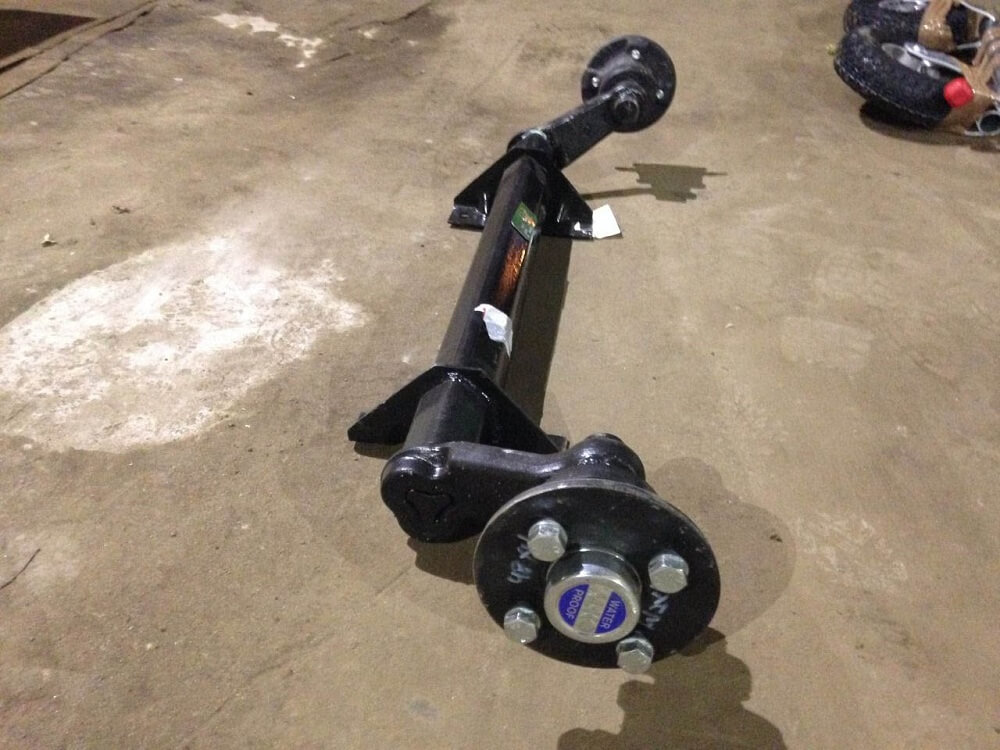
Which is the best trailer - spring or rubber-wired - it is up to the car owner to decide. The second type of suspension is cheaper and easier to maintain, has better cross-country ability, moves smoothly while driving, however, if a serious malfunction occurs, you will have to fork out a lot. Damage with a leaf spring suspension is not so expensive, and it can withstand overloads better.
Conclusion
In any case, in order to buy a quality trailer, you will have to pay a rather large sum. Not everyone has the means to afford such a device, especially if they need to use it several times a year. Some car owners install a towing unit and rent a trailer with suitable dimensions, in any case it will cost less than hiring a minibus with a driver. However, if you need to transport goods with a large mass at least once a month, you should think about purchasing your own trailer, which, with regular use, can quickly pay for itself.
The best prices and conditions for the purchase of new cars
Credit 4.5% / Installment / Trade-in / 95% of approvals / Gifts in the salonMas Motors








